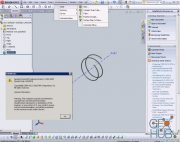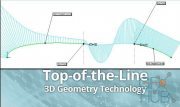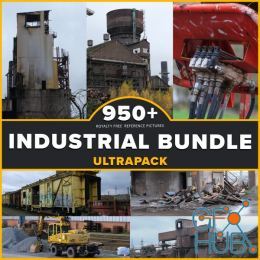Power Surfacing RE v6.1 for SolidWorks 2017 to 2021 Win x64

Power Surfacing RE v6.1 for SolidWorks 2017 to 2021 Win x64
Power Surfacing RE (Reverse Engineering) is the solution you need to get your job done effectively and quickly. Our Power Surfacing RE product has a unique set of tools to allow you to rebuild shapes in SOLIDWORKS® from a large variety of polygonal meshes. It can import meshes from: 3D scanners, Finite Element Modeling, 3D sculpting programs, 3D printer files, other polygonal modeling tools, and online polygonal model databases. Power Surfacing RE has the ability to constrain to and reference underlying meshes to capture the original design shape. The Power Surfacing RE tools enable you to quickly define a Power Surface shape over the top of the referenced mesh. With the existing Power Surfacing tools you will be able to modify and evolve the design.
Features
Includes the full Power Surfacing Toolset
Import meshes and display as a reference mesh
Convert existing SOLIDWORKS® geometry into reference mesh
Drawing tools with automatic face creation
Constrain points to reference mesh
Automatic retopologizing of enclosed areas
Add geometry to cover holes while matching curvature in reference mesh
Distance display to measure approximation of reference mesh
Interpolate or "vacuum seal" to closely approximate the reference mesh shape
New in Version 6.1
The 6.1 release is a power packed upgrade for Power Surfacing RE. Version 6.1 is a big boost to workflow efficiency, making Power Surfacing RE a powerful, unmatched tool for reverse engineering scanned meshes, other meshes, or SOLIDWORKS® geometry. The 6.1 version also includes many new general Power Surfacing tools (which are all included in Power Surfacing RE). See the Power Surfacing product page for an overview of the new Power Surfacing 6.1 features. See a video highlighting the new Power Surfacing RE 6.1 features. Here is a list of some of the major Power Surfacing RE new 6.1 features.
New Quad Wrap: improved for accuracy, speed, better topology. Will also automatically detect and close most open edges.
Improved Shrink Wrap: automatically checks for and fixes many self-intersections.
Mesh Smooth: new command that will smooth out the entire mesh. Great for messy imported mesh cleanup.
Mesh Offset: Offset the mesh to make a thickness.
Import point clouds (OBJ files)
Automated scanned mesh conversion
New automated conversion tools greatly simplify the process of converting scanned meshes into SOLIDWORKS® geometry.
video: Automated scanned mesh conversion
Superior accuracy
New patent pending technology allows customers to reverse engineer scanned meshes and capture / convert the fine details of the scanned mesh. Typically, capturing this high level of accuracy would create extremely large models (or even fail due to memory constraints). But with patent pending Power Surfacing RE technology, even large, highly detailed scans can be reverse engineered into accurate, editable SOLIDWORKS® geometry.
Follows curvature and mesh flow
Capturing the shape of a scanned mesh model is important, but it is also important to accurately follow the curvature and flow lines. Otherwise, creases, ridges, gullies and other features will wash out when converted into NURBS format. Power Surfacing RE uniquely follows the flow lines and features of the scanned mesh when converting it into NURBS / CAD geometry. The result is a super accurate, editable model, optimized for usage in the CAD environment.
Curvature driven surface knot density
Power Surfacing RE is highly intelligent in handling large scanned meshes. It uses patent pending technology to capture fine details, without bloating the model size. The result is an optimal, custom model based on the user's desired accuracy.
Topology Optimization
Power Surfacing RE can take SOLIDWORKS® "Topology Study" models and turn that data into usable SOLIDWORKS® solids geometry.
video: Topology Optimization
Semi-automated tools for finding and fixing anomolies
Even with the best scanners, the scanned meshes that are produced can have flaws and problems. Scanners may produce anomalies due to inaccuracy or scanning visibility (tears, rips, holes, overlaps, etc.). Scanned objects might also have edges or surfaces that are worn or damaged (the scanner may be accurate, but the objects themselves may be damaged); but users can restore those damaged edges / surfaces to their original, intended form using Power Surfacing RE. Power Surfacing RE has automated tools to identify the problem areas in the scanned mesh, and tools to fix those problems with a minimal amount of effort.
Download links:
PowerSurfacing_6_1_SW2017-2021.part1.rar
PowerSurfacing_6_1_SW2017-2021.part2.rar
PowerSurfacing_6_1_SW2017-2021.part3.rar
PowerSurfacing_6_1_SW2017-2021.part4.rar
PowerSurfacing_6_1_SW2017-2021.part2.rar
PowerSurfacing_6_1_SW2017-2021.part3.rar
PowerSurfacing_6_1_SW2017-2021.part4.rar
PowerSurfacing_6_1_SW2017-2021.part1.rar
PowerSurfacing_6_1_SW2017-2021.part2.rar
PowerSurfacing_6_1_SW2017-2021.part3.rar
PowerSurfacing_6_1_SW2017-2021.part4.rar
PowerSurfacing_6_1_SW2017-2021.part2.rar
PowerSurfacing_6_1_SW2017-2021.part3.rar
PowerSurfacing_6_1_SW2017-2021.part4.rar
PowerSurfacing_6_1_SW2017-2021.part1.rar
PowerSurfacing_6_1_SW2017-2021.part2.rar
PowerSurfacing_6_1_SW2017-2021.part3.rar
PowerSurfacing_6_1_SW2017-2021.part4.rar
PowerSurfacing_6_1_SW2017-2021.part2.rar
PowerSurfacing_6_1_SW2017-2021.part3.rar
PowerSurfacing_6_1_SW2017-2021.part4.rar
Comments
Add comment
Tags
Archive
| « December 2025 » | ||||||
|---|---|---|---|---|---|---|
| Mon | Tue | Wed | Thu | Fri | Sat | Sun |
| 1 | 2 | 3 | 4 | 5 | 6 | 7 |
| 8 | 9 | 10 | 11 | 12 | 13 | 14 |
| 15 | 16 | 17 | 18 | 19 | 20 | 21 |
| 22 | 23 | 24 | 25 | 26 | 27 | 28 |
| 29 | 30 | 31 | ||||
Vote
New Daz3D, Poser stuff
New Books, Magazines
 2021-03-21
2021-03-21

 1 846
1 846
 0
0

















